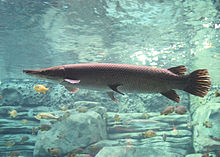| Large gars Temporal range: ~Santonian–Present, 86.3–0 Ma PreꞒ Ꞓ O S D C P T J K Pg N | |
|---|---|

| |
| Alligator gar | |
| Scientific classification | |
| Domain: | Eukaryota |
| Kingdom: | Animalia |
| Phylum: | Chordata |
| Class: | Actinopterygii |
| Clade: | Ginglymodi |
| Order: | Lepisosteiformes |
| Family: | Lepisosteidae |
| Genus: | Atractosteus (Rafinesque, 1820) |
| Type species | |
| Esox spatula Lacépède, 1803 | |
| Species | |
|
See text | |
| Synonyms | |
| |

Atractosteus ("spindle bone" in Greek) is a genus of gars in the family Lepisosteidae, with three extant species. It is one of two surviving gar genera alongside Lepisosteus.
The three surviving species are all widely separated from one another, with A. spatula being found in the south-central United States, A. tropicus in southern Mexico and Central America, and A. tristoechus in Cuba. Although generally inhabiting fresh water, they are tolerant of marine conditions.
Evolution
The genus first appeared during the Santonian stage of the Late Cretaceous, having diverged from Lepisosteus earlier in the Cretaceous. It quickly achieved a widespread distribution throughout the rest of the Cretaceous, being known from North America, South America and Europe. Atractosteus survived the Cretaceous-Paleogene extinction event, with one articulated fossil of the species A. grandei being recovered from strata dated to just a few thousand years after the extinction event, making it the oldest known articulated vertebrate fossil from the Cenozoic. It was found throughout North America and Europe during the Paleogene, but by the Neogene this had shrunk to only certain parts of North America, where it is still found today.
Systematics
| Lepisosteidae |
| ||||||||||||||||||||||||||||||||||||
Species
Extant species
| Image | Scientific name | Common name | Distribution |
|---|---|---|---|
 |
Atractosteus spatula Lacépède, 1803 | Alligator gar | Southern United States |
 |
Atractosteus tristoechus Bloch & J. G. Schneider, 1801 | Cuban gar | Western Cuba and the Isla de la Juventud |
 |
Atractosteus tropicus T. N. Gill, 1863 | Tropical gar | Southern Mexico to Costa Rica |
Fossils
- †"Atractosteus" africanus (Arambourg & Joleaud, 1943) (placement in Atractosteus disputed)
- †Atractosteus atrox (Leidy, 1873)
- †Atractosteus grandei Brownstein & Lyson, 2022
- †Atractosteus emmonsi Hay 1929
- †Atractosteus lapidosus Hay 1919
- †Atractosteus messelensis Grande 2010
- †Atractosteus occidentalis (Leidy 1856) non Wiley 1976
- †Atractosteus simplex (Leidy 1873)
Former fossil genera:
- †Atractosteus cuneatus (Cope 1884) non (Cope 1878) (now in Cuneatus)
- †Atractosteus falipoui (Cavin & Brito 2001) (now in Oniichthys)
References
- Szabó, M.; Gulyás, P.; Ősi, A. (2016). "Late Cretaceous (Santonian) Atractosteus (Actinopterygii, Lepisosteidae) remains from Hungary (Iharkút, Bakony Mountains)". Cretaceous Research: 239–252. doi:10.1016/j.cretres.2015.12.002.
- Froese, R.; Pauly, D. (2017). "Lepisosteidae". FishBase version (02/2017). Retrieved 18 May 2017.
- Van Der Laan, Richard; Eschmeyer, William N.; Fricke, Ronald (11 November 2014). "Family-group names of Recent fishes". Zootaxa. 3882 (1): 1–230. doi:10.11646/zootaxa.3882.1.1. PMID 25543675.
- ^ Doran Brownstein, Chase; Yang, Liandong; Friedman, Matt; Near, Thomas J (2022-12-20). "Phylogenomics of the Ancient and Species-Depauperate Gars Tracks 150 Million Years of Continental Fragmentation in the Northern Hemisphere". Systematic Biology. 72 (1): 213–227. doi:10.1093/sysbio/syac080. ISSN 1063-5157.
- Alves, Yuri Modesto; Montefeltro, Felipe Chinaglia; Cidade, Giovanne M. (2021-05-01). "New occurrences of Atractosteus (Ginglymodi: Lepisosteoidea: Lepisosteidae) from the Bauru Group (Upper Cretaceous, Brazil) and paleobiogeographic implications". Cretaceous Research. 121: 104735. doi:10.1016/j.cretres.2020.104735. ISSN 0195-6671.
- Szabó, Márton; Gulyás, Péter; Ősi, Attila (2016-05-01). "Late Cretaceous (Santonian) Atractosteus (Actinopterygii, Lepisosteidae) remains from Hungary (Iharkút, Bakony Mountains)". Cretaceous Research. 60: 239–252. doi:10.1016/j.cretres.2015.12.002. ISSN 0195-6671.
- Brownstein, Chase Doran; Lyson, Tyler R. (2022). "Giant gar from directly above the Cretaceous–Palaeogene boundary suggests healthy freshwater ecosystems existed within thousands of years of the asteroid impact". Biology Letters. 18 (6). doi:10.1098/rsbl.2022.0118. ISSN 1744-957X. PMC 9198771. PMID 35702983.
- Cavin, Lionel; Martin, Michel; Valentin, Xavier (1996). "Occurrence of Atractosteus africanus (actinopterygii, lepisosteidae) in the early Campanien of Ventabren (Bouches-du-Rhône, France). Paleobiogeographical implications". Revue de Paléobiologie. 15 (1): 1–7.
- Brownstein, Chase Doran; Lyson, Tyler R. (2022). "Giant gar from directly above the Cretaceous–Palaeogene boundary suggests healthy freshwater ecosystems existed within thousands of years of the asteroid impact". Biology Letters. 18 (6): 20220118. doi:10.1098/rsbl.2022.0118. PMC 9198771. PMID 35702983.
- Froese, Rainer; Pauly, Daniel (eds.). "Species in genus Atractosteus". FishBase. June 2011 version.
| Ginglymodi | |||||||||||||||||
|---|---|---|---|---|---|---|---|---|---|---|---|---|---|---|---|---|---|
| |||||||||||||||||
| Taxon identifiers | |
|---|---|
| Atractosteus | |
This Lepisosteiformes-related article is a stub. You can help Misplaced Pages by expanding it. |
